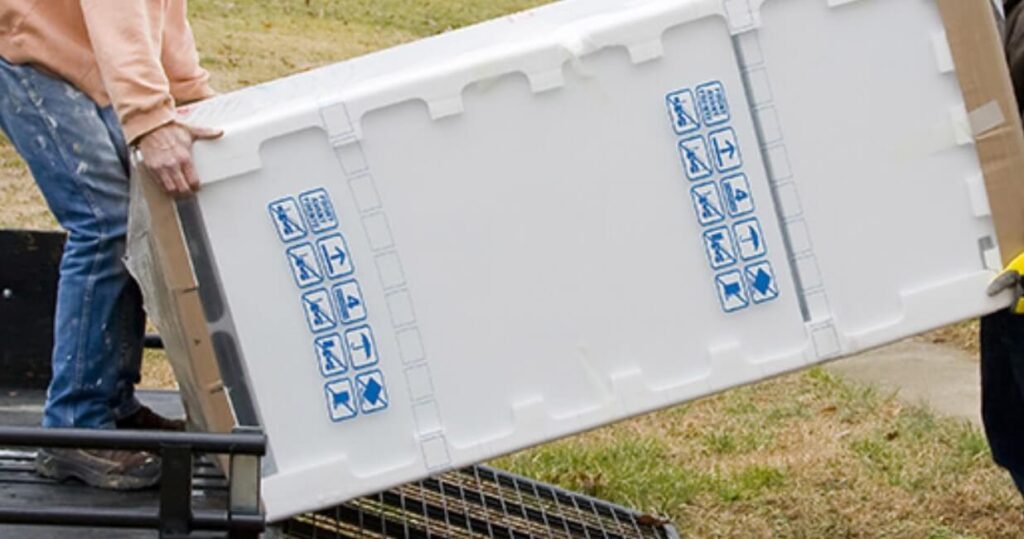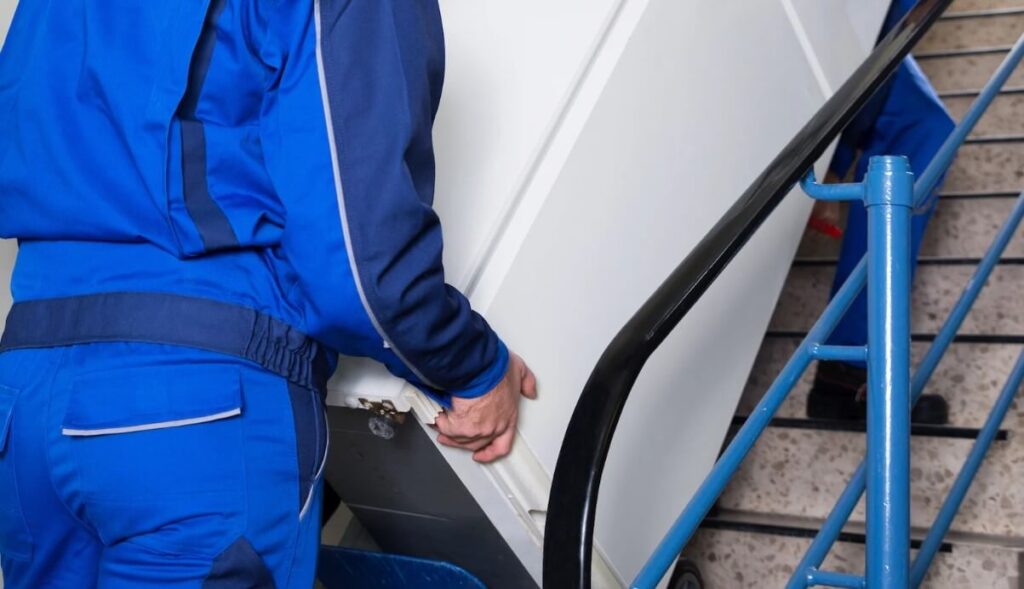Yes, an upright freezer can be laid down for transport. Before moving the freezer, you should empty it of all food since liquid items may spill out and cause damage during transport. Make sure to unplug the power cord from its outlet and remove any shelves or drawers that can be taken out.
Place a blanket on the ground in the direction you plan to move it and lay it flat on top of that. Securely strap the appliance to your vehicle using heavy-duty straps to prevent shifting while driving. Once at your destination, stand the freezer up again in its original position before reconnecting it to power source so as not damage insulation inside or other components within your refrigerator/freezer unit.
Moving a large upright freezer can be tricky, but it is possible with some extra preparation. Before you begin transporting your upright freezer, you should make sure that it is completely empty and any loose parts are secured. If the freezer has been stored for an extended period of time, allow it to stand in a vertical position for about 8 hours before laying down for transport.
Once the upright freezer is ready, carefully lay it flat on its side so that none of the components inside are damaged during transit. Make sure to secure all sides with heavy blankets or straps to ensure safe transportation!

How Do You Transport an Upright Freezer?
Transporting an upright freezer can be a tricky task, especially if you don’t have the right equipment. To ensure that your appliance is safely transported to its new home, it’s important to take measures so that the moving process is as safe and straightforward as possible.
First and foremost, turn off the freezer at least 24 hours before you plan on moving it; this will give enough time for all of the ice inside to thaw out.
Next, empty out any food or items from inside of your freezer; these should be placed in coolers with ice packs during transit so that they don’t spoil during transport. Use towels to protect both the interior and exterior components of your freezer from damage due to bumps along the way.
Finally, make sure that someone is available who can help lift and move your appliance – two people are almost always necessary when relocating an upright freezer!
Once you’ve taken all of these steps into account, then you’re ready to drive away with your newly relocated upright freezer!

When transporting a fridge does it need to be upright?
Yes, when transporting a refrigerator, it is generally recommended to keep it upright. Refrigerators contain a compressor and refrigerant that are designed to work properly when the appliance is in an upright position.
Transporting a fridge on its side or at an angle can potentially cause the oil in the compressor to flow into the refrigerant lines, leading to potential damage to the compressor and affecting the cooling system’s efficiency. Additionally, if the fridge is tilted too much, it can cause internal components to shift or even break, leading to possible malfunctions.

Can you transport upright freezer laying down?
While it is possible to transport an upright freezer laying down, it is not recommended due to the potential risks and damage it can cause. Whenever possible, it is best to transport the freezer in an upright position to ensure the longevity and proper functioning of the appliance.
If circumstances require transporting the freezer horizontally, following the best practices outlined above can help minimize potential damage.
Is it possible?
Yes, it is possible to transport an upright freezer laying down. The decision to transport it in this manner often arises from practical reasons, such as limited space in a moving vehicle or the need to maneuver the freezer through narrow doorways or staircases. However, it is important to note that while it is possible, it is not the recommended method of transportation.
Why is it not recommended?
Transporting an upright freezer laying down can pose certain risks and potential damage to the appliance. Here are a few reasons why it is not recommended:
- Compressor damage: The compressor, a crucial component of the freezer, is designed to work optimally when the appliance is in an upright position. Transporting it horizontally can cause oil to flow into the cooling lines, potentially leading to compressor damage or reduced efficiency.
- Door seal damage: Laying the freezer down may cause the door to shift or bend, potentially leading to damage to the door seal. A compromised door seal can result in poor cooling performance and increased energy consumption.
- Internal damage: The internal components of an upright freezer, such as shelves, drawers, and internal mechanisms, are not built to withstand the weight and pressure when laid on their sides. There is a risk of these components shifting or breaking during transport.
- Cooling system issues: Transporting an upright freezer in a horizontal position can disrupt the cooling system, as the coolant may not flow properly. This can impact the freezer’s ability to reach and maintain the desired temperature, potentially resulting in food spoilage.
How to Transport An Upright Freezer?
While transporting an upright freezer in a vertical position is the ideal method, there are situations where laying it down becomes necessary. If you must transport an upright freezer in a horizontal position, here are some best practices to minimize potential damage:
- Empty the freezer: Before moving the appliance, make sure to remove all items from the freezer. This reduces the weight and minimizes the risk of damage to the internal components.
- Secure the doors: Use tape or bungee cords to secure the freezer doors tightly. This helps to prevent them from opening during transport and causing potential damage to the door seal.
- Protect the appliance: Place blankets or other padding around the freezer to provide cushioning and protect it from scratches or dents. Additionally, secure the appliance in a stable position within the transportation vehicle to avoid movement.
Can a New Freezer Be Transported on Its Back?
Yes, a new freezer can be transported on its back. This is the safest way to transport any type of bulky appliance such as a refrigerator or freezer. It allows for more control over the handling and movement of the item, which reduces the risk of damage during transit.
When moving a new freezer, it should be secured with straps or padded blankets to ensure that it will not slide off due to bumps in the road.
Also, remember to always keep your hands away from any sharp edges or areas where you could potentially cut yourself while lifting and shifting the unit around.
Additionally, if possible, enlisting help from another person when transporting large items like this is highly recommended as two people are better than one when trying to safely move an object!
Can You Lay a Fridge Freezer on Its Side to Transport It?
Yes, it is possible to lay a fridge freezer on its side while transporting it. However, there are some important steps you should take before doing so in order to avoid any damage.
First, make sure the fridge and freezer have been unplugged from the wall socket and defrosted for at least 24 hours in advance of transportation.
Once that’s done, secure all shelves and drawers within the appliance with tape or bands – this will prevent them from moving around during transit and causing damage either internally or externally. You can then use blankets or mats to cushion the sides of your refrigerator before laying it on its side; this will minimize any potential scratching as you move it around.
Lastly, be sure to keep your appliance level while being transported as tilting too much could cause fluids inside to leak out.
All these precautions should ensure that your refrigerator remains undamaged throughout its journey!

What is the Compressor Side of an Upright Freezer?
The compressor side of an upright freezer is the most crucial component in its working. It is responsible for cooling down the food and maintaining a consistent temperature within the appliance. The compressor works by drawing air from outside the unit, compressing it, and sending it to a condenser before releasing it into the interior of the freezer.
This process creates cold air which keeps your food at a safe temperature while using minimal energy compared to other types of refrigeration systems. Compressor sides come in different sizes and styles depending on what type of model you have, so make sure you know which one you need before making any purchases.
Additionally, they can sometimes require maintenance or replacements if they become damaged or worn out over time due to age or wear-and-tear.
Can you lay your refrigerator or freezer on its side for transporting?
Can I Lay a Freezer down to Transport It?
Yes, you can lay a freezer down to transport it, provided that it is an upright model. Make sure the freezer’s door or lid remains open during transit to reduce pressure on the seals and prevent potential damage.
Additionally, be sure to secure the appliance with straps or blankets so that it doesn’t move around too much while in transit.
What is the Compressor Side of a Freezer?
The compressor side of a freezer is the section where the cooling process happens. This part houses the compressor, condenser coils and fan, all of which work together to create cold air for your refrigerator. The compressor pressurizes and circulates refrigerant gas around in order to cool down the temperature inside your fridge.
Whenever you adjust the settings on your thermostat, it will affect how often this process occurs, making sure that everything stays at a comfortable temperature within your refrigerator compartment.
How Long Can a Freezer Lay on Its Side?
If you need to transport a freezer, or if it needs to be stored in an area that requires it to lay on its side, the simplest answer is that you can do so for up to 24 hours. While a longer period of time may not damage your appliance immediately, the manufacturer recommends only laying your freezer on its side for 24 hours or less.
It is important to note that any food items should be removed from the freezer before transporting or laying it on its side, otherwise, they may suffer damage due to extreme temperature changes during transit.

Moving Freezer Short Distance
Moving a freezer can be a tricky task. It is important to take the proper precautions in order to ensure that your food stays fresh, and that no damage occurs during the move. When moving a freezer just a short distance, it’s best practice to keep it upright at all times and place it on its side only if absolutely necessary.
Make sure you empty out any perishables prior to transport and wrap up cords for added safety measures. For longer moves, consider purchasing an insulated blanket or crate for extra protection; however, these are not typically necessary when making shorter journeys with your appliance.
Lay down Freezer
A lay down freezer is an efficient way to store large amounts of food for long periods of time. It’s perfect for commercial kitchens, restaurants, and grocery stores that need to keep a lot of frozen items on hand at all times. Lay down freezers have shelves or drawers which make organizing and accessing foods easy, plus they use less energy than upright freezers.
If you’re in the market for a reliable freezer option with plenty of space and energy savings benefits, then consider investing in a lay down freezer today!
How to Transport a Freezer?
Moving a freezer can be a tricky task, but with the right preparation and tools it can be done safely. Firstly, you should make sure that your freezer is completely defrosted and drained of water before moving. Secondly, use protective blankets or bubble wrap to secure the back corners of the freezer.
Lastly, when transporting the appliance make sure to keep it in an upright position at all times to avoid any damage occurring due to liquid spilling inside.
Moving Freezer Without Defrosting
Moving a freezer without defrosting it is possible; however, it can cause damage to the unit, particularly if it has not been properly prepared for the move.
To minimize any potential damage and ensure that your food stays frozen during transport, you should make sure that all of the contents are well-packed and securely sealed to reduce air circulation within the freezer.
Additionally, packing materials such as blankets or bubble wrap should be used to cushion the sides of your freezer against bumps or blows during transportation.
Moving a Freezer from One Room to Another
Moving a freezer from one room to another can be challenging, especially if the freezer is large and heavy. Before attempting this task, make sure you have enough help available to safely lift and carry the freezer. Additionally, it’s important that your path is clear of any obstacles, since you don’t want to risk damaging either your walls or floors!
Make sure all food items are properly sealed in airtight containers before transporting them so nothing will spill inside the unit. Finally, once you reach your destination room, allow for some time for the compressor to cool back down before plugging it back into an outlet.
Can I lay a fridge freezer down to transport it?
Transporting a fridge freezer by laying it down is generally not recommended, as it can potentially cause damage to the appliance. Refrigerators and freezers are designed to operate in an upright position, and laying them down can lead to various issues:
- Compressor Damage: The compressor, which is a crucial component for cooling, contains oil that needs to stay in a specific place. Laying the fridge freezer down can cause this oil to flow into the refrigerant lines, potentially damaging the compressor and affecting cooling efficiency.
- Cooling System Issues: The cooling system relies on proper circulation of the refrigerant. Tilting the appliance can disrupt this circulation and lead to problems with cooling performance once the appliance is returned to an upright position.
- Interior Damage: When laid down, the contents inside the fridge freezer can shift and potentially damage the interior components like shelves, drawers, and other internal structures.
- Condensation: If the fridge freezer is laid down and then brought upright, condensation can form inside due to temperature changes, potentially affecting electrical components and causing water damage.
If you absolutely need to transport a fridge freezer, it’s best to keep it upright throughout the process. If you must lay it down for a short period of time (for example, when maneuvering through a doorway), try to keep the angle as minimal as possible and return it to an upright position as soon as you can.
Conclusion
In conclusion, while an upright freezer can be laid down for transport, it is not recommended as the best way to move one. Instead, it is best to use a dolly or strong straps and rope to secure the freezer in place before moving.
It is also important to remove all food from the freezer prior to moving and ensure that you wait long enough for any ice buildup within the unit itself to thaw out completely before transporting it.
Doing so will help protect both your appliance and your property during transit.
